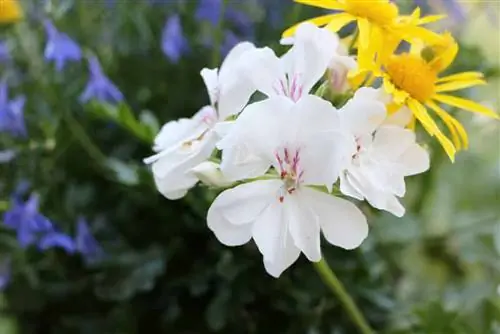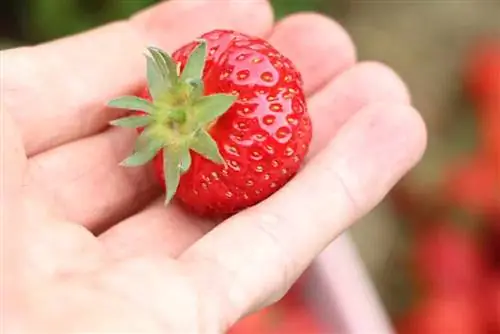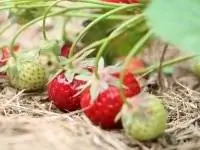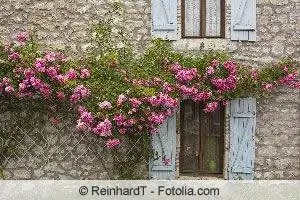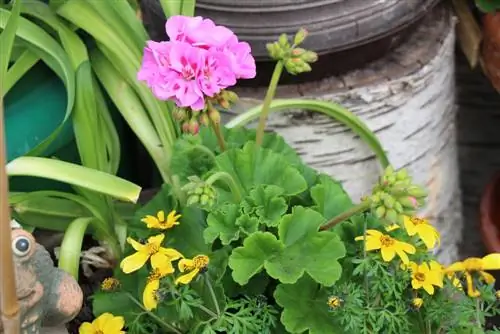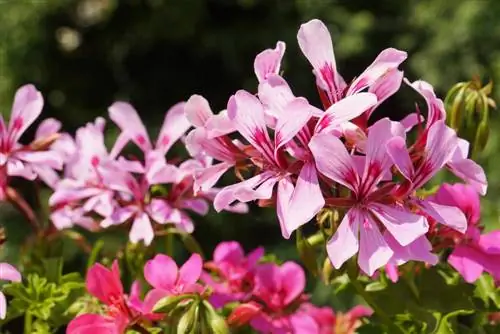- Author admin [email protected].
- Public 2023-12-17 03:39.
- Last modified 2025-01-24 12:45.
Pelargoniums are easy-care plants and attractive permanent bloomers. Colloquially, these are better known as geraniums. Pelargoniums have the botanical name Pelargonium and originally come from southern Africa. The colorful flowering plants are not hardy, but due to their origin they tolerate the summer heat very well. That's why they're ideal for balcony boxes, planters and hanging baskets.
Location & plant substrate
Pelargoniums prefer warm locations so that they can produce beautiful flowers. In locations that are too dark and cold, the flowers gradually wither. The geraniums also cannot tolerate soil that is too heavy and clayey, or long-term drought. Due to the delicate nature of the flowers, exposed locations are not suitable.
- Very sunny and protected locations are optimal
- Need several hours of sunshine per day
- Make sure the plant substrate is well-drained and nutrient-rich
- Substrate should store enough water
- Special geranium soil with lots of nutrients is ideal
Tip:
The flowers are very delicate and delicate, so protection from heavy rain is recommended. Otherwise, the delicate petals will stick together after a heavy downpour and then die.
Plants
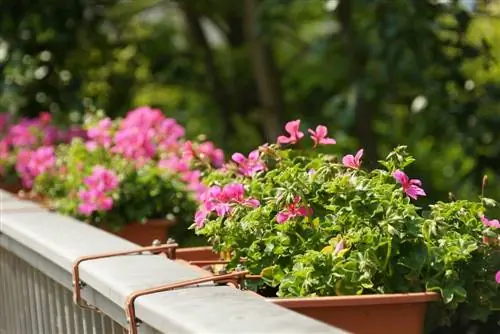
Pelargoniums have developed into popular balcony plants in these latitudes. Planting in a garden bed is also possible, but due to their lack of winter hardiness, these specimens must then be relocated to a frost-free winter quarters in good time before the onset of winter. Planting is only possible when the nights are completely frost-free. It is important to make sure that the individual specimens are not too close to each other. Otherwise, the geraniums will hinder each other's growth as they spread widely in all directions.
- Suitable for hanging baskets, flower boxes and pots
- Plant mid/late May at the earliest, after the Ice Saints
- Don't plant too closely, about 4 plants per 1 meter
- Root ball should be able to soak up water first
- Lay out a drainage layer in the planter to protect against waterlogging
- A 2-3 cm thick layer of gravel is ideal
- Press the soil down well and then water it
- Not suitable for hydroponics
Watering & Fertilizing
For brisk growth and abundant flowering, pelargoniums depend on lots of nutrients and sufficient water. Longer dry periods should be avoided, as these only weaken the geraniums unnecessarily. However, never water directly over the leaves and flowers, otherwise a breeding ground for diseases will be created, for example the risk of pelargonium rust increases. The distinctive plants are heavy feeders and require significantly more nutrients to produce rich flowers than comparable balcony plants.
- Water regularly and abundantly
- Make sure the plant substrate is evenly moist
- Avoid waterlogging at all costs
- Water only when the top layer of soil is dry
- Wate in the morning and evening when it is very hot in summer
- Always water from below
- Special geranium fertilizers are ideal
- Use long-term fertilizer when planting
- Additional liquid fertilizer during the flowering period
- Fertilize every 1-2 weeks
Cutting
Geraniums can be pruned several times a year, which stimulates compact growth and increased flower production. Pruning is an important part of care; the plant is initially kept smaller. In the long term, however, this leads to dense and shapely branching.
- Pruning before overwintering
- September or October is ideal, early before the hibernation period
- The beginning of spring is also good for cutting
- Remove old leaves and wilted flowers
- Also cut back new and bright shoots
- Leave about 2-3 eyes per stem
Tip:
If the plant produces too many new shoots, some of these shoot tips should be trimmed.
Wintering
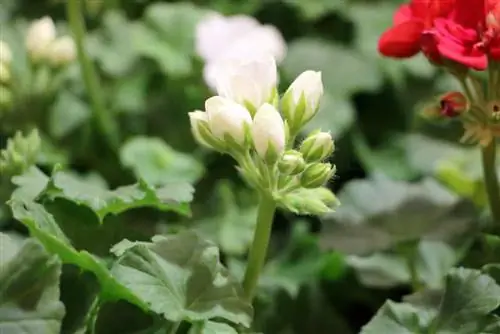
Pelargoniums are not frost hardy and would not survive the winter outside. Therefore, the plants must either be moved with their container to a suitable winter quarters or dug up from the garden bed. In late autumn it is time to prepare the geraniums for their winter rest. By then, most of the geranium's leaves have already fallen, but the flowers can continue to bloom. The winter quarters must have cool temperatures; if it is too warm, the plants will sprout prematurely. The darker the lighting conditions in the winter quarters, the lower the temperatures should be. Do not allow the plants to dry out completely during winter rest.
- Transfer flower pots to frost-free winter quarters
- Removing plants from the soil when cultivating in the garden
- Proceed carefully to avoid damaging fine roots
- After digging up, place 2-3 pieces in small pots at a time
- Cover with a mixture of potting soil and sand
- Dark room is ideal for storage
- Cool temperature values are optimal, up to a maximum of 10° C
- Water lightly every now and then
Propagate
Pelargoniums can be easily propagated and cultivated on your own. Propagation is possible by sowing, cuttings and division:
Sowing
Pelargoniums can be grown indoors in the winter season and then moved outside after the late frosts have ended. On frost-free days, the young plants can be put outside during the day to harden off, but have to be brought back in in the evening.
- Advance from January
- Spread seeds in potting soil in the growing container
- Cover lightly with substrate and keep evenly moist
- Repot individually in small pots when the first leaves appear
- Ideal is a bright but still cool location
- Moving to the final outdoor location from the end of May
Cuttings
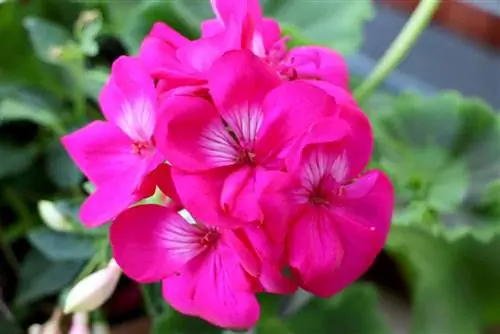
Propagation by cuttings is a simple and quick method to obtain new plants. However, the mother plant should be strong and he althy so as not to put unnecessary strain on it. After a few weeks, the first roots usually form, then the cuttings can be moved individually into a planter and gradually watered more. When growing cuttings in autumn, they should overwinter in cool but frost-free temperatures. Keep the planting substrate much drier than when taking cuttings in spring. At the beginning of spring, place the young plants brighter and warmer again and move them outside after the last late frosts.
- Possible in both spring and autumn
- Cut cuttings below the leaf node
- Approx. 5-10 cm long, without flower base
- Remove lower leaves, flower stalks and buds
- Leave 2-3 leaves above
- Place cuttings about 2 cm deep in potting soil
- Leave enough space for neighbors
- Press the substrate carefully and water it lightly
- At the beginning, keep the soil only moderately moist
- Bright east and west windows are ideal as a location
- Avoid direct sunlight
- Overwinter at 5-10° C
Division
With perennial pelargoniums, division of the mother plant is possible, but only if it has he althy and strong growth.
- Share approximately every 4-5 years
- Carry out in April, before budding begins
- Remove substrate and carefully divide roots
- Replant sections individually with enough spacing
- Water regularly but not excessively
Popular varieties
Pelargoniums are extremely versatile and offer a lot of variety in terms of flowers, leaves and growth habit. The varieties can be divided into different groups, which are defined by certain characteristics:
Upright geraniums
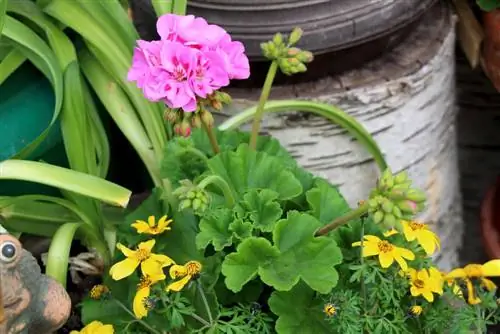
The upright varieties form fleshy leaves with slightly hairy stems. The growth height is up to 35 cm and the flowers seduce with a true splendor of shapes and colors.
- Form semi-double and fully double flowers
- Flowers in pink, purple, white, plus shades of orange, red and pink
- Grandeur Light Pink Splash
- Colorful graffiti varieties
- Stellar varieties with star-shaped flowers
Hanging geraniums
Hanging geraniums are ideal for balcony boxes and hanging baskets; they can grow up to 1.50 m long. These pelargoniums have self-cleaning properties, which means that withered plant parts fall off on their own and do not have to be removed by hand.
- Growing strong
- Cascade varieties
- Ville de Paris
fragrant geraniums
The leaves of the fragrant geraniums exude a pleasant, spicy scent that can vary greatly depending on the variety. These intense scents can drive away mosquitoes and wasps. The growth height can be up to 40 cm, the flowers are either one or two colors. However, these are quite small and play a minor role in scented geraniums.
- Chocolate Peppermint smells like chocolate
- Queen of Lemons seduces with lemon scent
- Purple Unique has an aroma of wine gums
- Bourbon smells pleasantly like roses
- Lady Plymouth enchants with the scent of peppermint
- Orsett is peppery-lemony
- Leaves are suitable for flavoring drinks and dishes
Leaf decoration geraniums
These varieties enchant with their eye-catching and colorful leaf markings. The growth heights are between 20-30 cm.
- White, yellow or green leaf decoration
- Robust Pelgardini varieties
geraniums
The noble pelargoniums are usually cultivated for indoor storage; a bright location with warm temperatures all year round is ideal. The growth is upright and compact, the leaves are jagged at the edge.
- Clarion Violet blooms in bright pink with a dark eye
- Velvet Red in velvety purple violet
Diseases & Pests
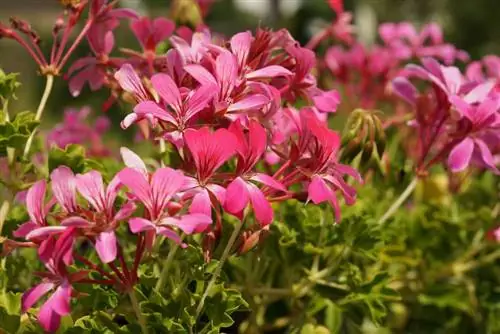
If care mistakes are made, the geraniums become significantly more susceptible to diseases and pests. The causes of diseases often include permanently wet leaves. As a preventative measure, always water the plants from below and not directly over the leaves. Extremely cool weather, a constant lack of light and excessive fertilization also weaken the pelargonium's immune system. Pests can be controlled with environmentally friendly home remedies, but the treatment must be repeated often as they can be very stubborn. If there is a particularly severe infestation, the affected parts of the plant must be completely removed. Otherwise, the pests spread extremely quickly and, in the worst case, also attack neighboring plants.
- Susceptible to aphids, thrips and whiteflies
- Wash off pests with soapy water
- Lye must not get on the substrate
- Cover soil with foil
- Susceptible to geranium rust, a contagious fungal disease
- Brown spots form on the top of the leaves
- There are brown-yellow colored pustules on the undersides of the leaves
- Dispose of infected plants, they can no longer be saved
- Grey mold cannot be controlled either
- Gray-black spots form
- Plus a gray mushroom lawn
- Immediately remove affected plant parts in the initial stage
- Bacterial wilt manifests itself as oily spots on leaves
- Infected leaves wilt, turn black and die
- Same procedure as for the other diseases

